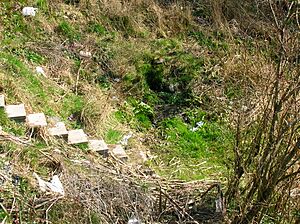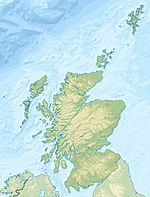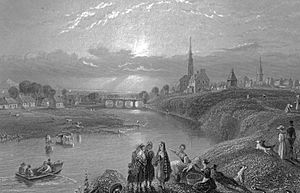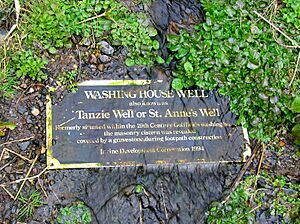Tanzie Well facts for kids
The Tanzie Well is a special water spring located next to the River Irvine in Irvine, Scotland. You can find it in the area known as the Golf-fields, right at the end of the footbridge that crosses the river. People also call it Saint Anne's Well, the Washing House Well, or even the Spoot. Some people think the name 'Tanzie' might have come from 'St Inan's Well'. Close by, there's an old building from 1801 called the Irvine Pouther House, which used to store gunpowder.
Contents
What the Tanzie Well Looks Like
This well, which is like a natural spring, sits below a walking path near the River Irvine footbridge. You can reach it by walking down some concrete steps. There's a special sign, or plaque, on the well that tells its name and a bit about its past. This plaque was put there in 1994 by the Irvine Development Corporation.
The water from the well flows into a stone channel that leads down to the River Irvine. The water comes straight from the ground, and it's always flowing. First, the water collects in a concrete tank, and then it's piped out to where you can see it. Long ago, there was a metal pipe where people could collect the water to take home.
In 2008, a person named Elis White remembered the well from the 1940s. She said the water was the purest, clearest water. She thought it might have appeared when a nearby loch, Scott’s Loch, was drained. People often came to the well to get water, especially for those who were sick. She remembered going with her father to get water for her grandmother.
The old maps, called Ordnance Survey maps, show that the land above the well was part of the Golf Fields. These maps also show that there have always been trees around the well. You can still see plants that grow in old woodlands there, like bluebells and red campion.
The plaque from 1984 also says that the well was found when the footpath was being built. It was covered by an old gravestone. For a long time, a pipe carried water out, but it was broken by a company and never fixed, even though local people wanted it back.
History of the Well and Washing House
The Old Washing House
In 1749, the Irvine town council built a special house near the Tanzie Well. This building was used for washing and bleaching clothes. It was about 35 feet long and 15 feet wide. An old map from 1829 shows this area as a bleachfield, which is a field where clothes were spread out to dry and whiten in the sun.
By 1856, maps showed the bleachfield and the wash house, with the round well below them. Each had its own path. In 1895, the path to the well changed and only led to the wash house. By 1908, the wash house was still there, but it wasn't called a "wash house" on the maps anymore. By 1938, the wash house was gone. Records show it was taken down in 1924. The slates from its roof were used to fix the nearby Powder House.
The Tanzie Well Through Time
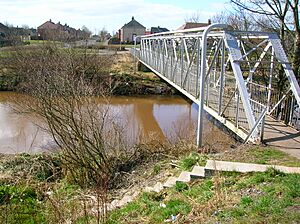
The Tanzie Well is shown on maps from 1856. Back then, a path branched off from the lane leading to the washing house to reach the well. It's possible the well and the washing house got their water from the same place. However, the dirty water from the washing house would have flowed away separately so it wouldn't make the well water dirty.
By 1895, the well was still on the map, but there was no longer a path leading directly to it. The path that used to go to the well now only went to the wash house. In 1908, the well was still marked on maps, but again, no paths led to it. By 1938, the well was not shown on maps at all, only the channel that carried water from the area to the river.
Saint Anne's or Saint Inan's Well
The name 'Tanzie' might come from 'St Anne' or 'St Inan'. Saint Inan is a saint linked to Irvine, and there used to be a well named after him in Fullarton, which is south of the current harbour. Dundonald Castle also had a chapel dedicated to Saint Inan. He is mostly connected with the town of Beith.
Plants Around the Well
The area around the Tanzie Well is home to many interesting plants. You can find plants that like wet places, like hemlock water dropwort. There are also plants that only grow where the water is clean and always flowing, such as watercress.
Other plants you might see include green figwort, brooklime speedwell, and wild angelica. You might also spot opposite-leaved golden saxifrage, green alkanet, and reed canarygrass. Some larger plants like giant hogweed, bishopweed, celandine, and Himalayan balsam also grow there.
See also


